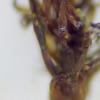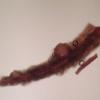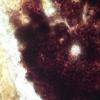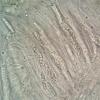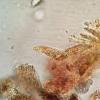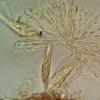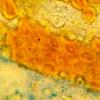
24-12-2025 17:08
Hulda Caroline HolteHello, I have found this propoloid ascomycete on

21-12-2025 09:32
Hello.A tiny ascomycete found embedded in wood in

21-12-2025 21:32
Pol DebaenstHello, Garden, Burgweg 19, Veurne, BelgiumOn 10/1

22-12-2025 23:38
Patrice TANCHAUDBonsoir, récolte sur un mur en pierre, apothéci

22-12-2025 00:47
Patrice TANCHAUDBonsoir, récolte à proximité du milieu dunaire
Unknown Ascomycete on Ulota bruchii
Georges Greiff,
22-08-2019 18:35
I have been going through herbarium specimens of Ulota in search of bryophilous ascomycetes for the past week. The following fungus is represented in 2/60 vouchers examined so far as well as one recent collection by me where living material was briefly examined. I have struggled to place this collection in taxonomic context and was hoping for suggestions.
Fruitbodies solitary or gregarious, superficial, hairless, dull orange at first but turning dark grey with age, around 125 - 200um with round ostiole 17 - 21 in diam. Excipulum dense, not yet examined by sectioning.
Most material has been too scarce to make good measurements. I can include these later if they would help, though I think this species is currently undescribed so they are probably not much use.
Asci octosporous, bitruncate, variable in width, blunt-ended, hyaline, reacting J+ blue at the tips in Baral's Iodine (very difficult to see in images). Paraphyses / paraphysoides difficult to visualise, seemingly forked at the base, 1.5-2 wide, slightly longer than asci with some kind of Iodine-staining bodies in them.
Ascospores hyaline, dense with guttules, particularly in the living collection which obscures the septa, consistently 3-septate when mature, slightly constricted at middle septum. Guttules disappear in Lactophenol Cotton Blue and have receeded but not disappeared completely in herbarium material.
Hyphae pale brown, superficial, thin-walled, septate. Appressoria not yet identified. I think I have visualised haustoria in several cells as shown in images. The nutrition seems to be necrotrophic based on my recent collection, as host plants were turned grey when colonised. This is in contrast to the usual brown colour of older plants of this moss.
There are some similarities in the microscopic structures to the following species found on related hosts:
http://www.ascofrance.com/forum/55767/orange-on-ulota-crispa
However, this species is perithecioid so I am skeptical that it is related to Belonium coroniforme.
Any pointers would be very much appreciated.
Thanks,
Georges
Georges Greiff,
22-08-2019 18:46
Re : Unknown Ascomycete on Ulota bruchii
I should say that I have extensively searched the literature relating to bryophilous ascomycetes and have not found any matching species, though it is possible that a similar species is in a paper that is unavailable to me. Mosses in the family Orthotrichaceae do not seem to have been examined extensively as hosts for microfungi in past studies.
